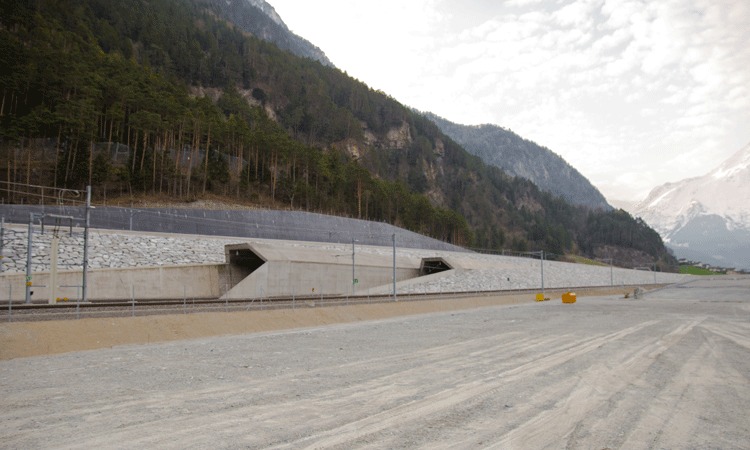Bringing Europe closer together with the Gotthard Base Tunnel
Posted: 6 August 2015 | Peter Füglistaler | No comments yet
In June 2016, the 57km-long Gotthard Base Tunnel under the Alps, which links northern and southern Switzerland, will be formally opened. The tunnel breaks a number of records. It is the longest rail tunnel in the world – 3km longer than the Japanese Seikan tunnel, the previous record holder. Peter Füglistaler – Director of the Federal Office of Transport in Switzerland – explains the importance of this route for commercial freight and passenger trains once scheduled operations through the tunnel begin in December 2016.


Building the tunnel through gneissic rock and granite but also through a large number of problem areas represented a major technological achievement. After a construction period lasting 17 years, the work of the planners, tunnellers, civil engineers, electricians, electronics specialists and many other people is now coming together to produce a modern high-performance rail system deep under the Alps.
The Gotthard tunnel is a major infrastructure project that not only connects different parts of Switzerland, but also northern and southern Europe. An efficient rail system on the Gotthard axis has always been important for the rest of Europe. Switzerland’s neighbours, Germany and Italy, bore the majority of the costs of the original Gotthard rail tunnel, which was opened in 1882, so that they could reap the benefits of an improved north-south link. The modern base tunnel, which has cost approximately €10 billion to build, has been financed solely by Switzerland. It represents the Swiss contribution to improving European rail transport and bringing a united Europe even closer together.
The Gotthard base tunnel will help to modernise rail transport between the Netherlands, Germany, Switzerland and Italy. It will significantly reduce journey times for passenger and freight trains and make rail transport more attractive. As a level route with only a few inclines, the Gotthard base tunnel will complement the existing mountain routes and will allow for higher speeds and heavier freight trains with fewer locomotives. Importantly, considerably more trains will be able to pass through the Gotthard in future than is currently the case. The line is fitted with equipment that meets the requirements of the European TSI (Technical Specifications for Interoperability) and ERTMS (European Railway Traffic Management System).
This structure of the century will make a significant contribution to the modal shift of transalpine freight transport from road to rail, which has been supported by the Swiss people in several votes. In order to enable the full potential of the new tunnel to be exploited, Switzerland will be expanding the northern and southern approach routes by 2020, so that in the future it will be possible to transport semi-trailers with a corner height of 4m by rail along the entire Gotthard axis. Over the last 20 years, the proportion of these semi-trailers crossing the Alps by road has doubled and is now around 60%. For shipping and transport companies, intermodal transport of this kind brings both logistical and financial benefits. The so-called 4m-corridor will allow the railways to offer solutions that meet the needs of the market.
The base tunnel was designed from the very beginning for transporting vehicles with a corner height of 4m. Now, around 20 tunnels are being enlarged on the existing approach routes in Switzerland and 150 obstacles, such as station platform roofs and signalling systems, are being modified. Switzerland is also providing support for enlargements on the cross-border route from Bellinzona to Gallarate (the so-called Luino line) to accommodate a 4m corner height and for the construction of additional terminals in the Milan area to allow large semi-trailers to travel in combined transport directly to the Milan economic area, or from there in the direction of northern Europe. The construction of the 4m-corridor and the building of additional terminals are key measures which will further reinforce the modal shift effect of the Gotthard base tunnel.
It is also important for the long-term success of the new rail tunnel that Germany and Italy increase the capacity of their approach routes on the north-south axis as contractually agreed. We are in regular contact with the authorities in both countries to ensure that the work is making good progress.
Switzerland is also actively involved in the development of European rail corridors, including the Rhine-Alpine corridor from Rotterdam to Genoa and the Benelux-France corridor, which runs from Antwerp to Basel. The corridor organisations have been given the task of harmonising the infrastructural and operational requirements for Europe-wide rail freight transport.
Organisational, technical and operational standardisation measures will also contribute to the success of European rail transport, alongside the construction of new infrastructure. Unfortunately, often taking a long time to implement.
I am sure that the Gotthard base tunnel, together with the 4m-corridor, the expansion measures in neighbouring countries and the development of the European rail freight corridors, will significantly strengthen rail transport in the heart of Europe. The railways will become more competitive in the interests of Europe, Switzerland and, most importantly, the environment.







